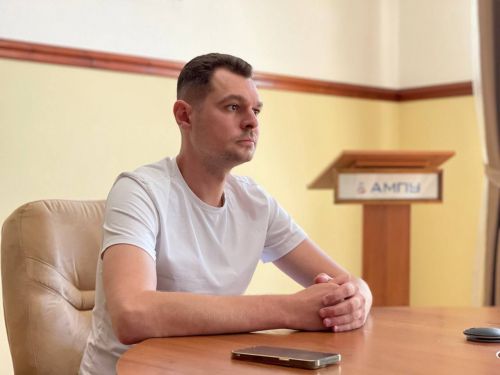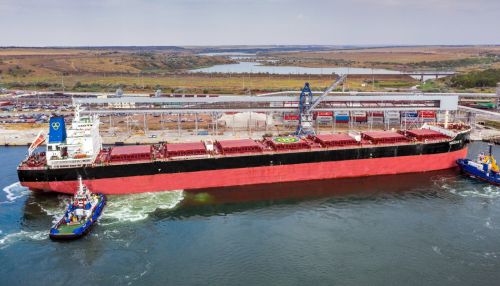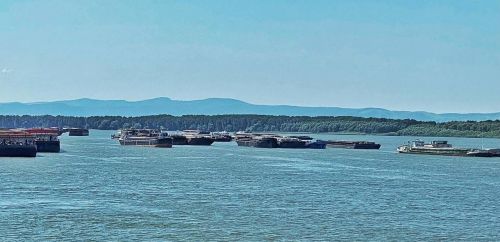Ukraine signed an initiative with the United Nations and Turkey on opening a safe maritime "grain corridor" from the ports of Greater Odesa in Istanbul on 22 July.
In an interview that had been taken few days before the “grain corridor” started working, the Ukrainian Seaports Authority’s acting head Oleksii Vostrikov, who has been holding this position since the end of June, discusses how this process takes place, the USPA’s role in it, and what is currently happening in the Danube.
Tell us how you were appointed to this position. Why was there no competition?
I was appointed as the acting head, a position for which, according to the law, a competition is not held. The approval of the supervisory board, the work of which is currently suspended at the USPA, is sufficient for such personnel changes. Firstly, because the Ministry of Finance has recommended suspension of the work of the supervisory boards of companies and, secondly, a new competition needs to be held because the terms of two members of the board have expired. Therefore, the decision to appoint me was made by the Ukrainian Ministry of Infrastructure, who is the owner. The procedure will be restored when peace returns.
What tasks did the ministry set for you?
To speed up all processes as much as possible, put the bureaucracy on the back burner, and bring goals and results to the fore. Rapid achievement of these tasks is the most important thing in the current realities.
The main thing is to develop the company with the tools that are currently available, prepare for peacetime, and, accordingly, maintain the infrastructure facilities in all the USPA’s ports in working condition, excluding the four ports that are currently located in the temporarily occupied territories.
During a war and a difficult economic situation, it is impossible to talk about development. The blockade of the Black Sea has significantly affected our income. The three ports that are currently open can hardly handle the cargo volumes that we had before. Accordingly, it is quite difficult to generate the revenues to cover all our expenditures. In addition, it is important to keep port employees and the management team.
What are the main items of the USPA’s expenditures now?
The company is idle (except for three Danube ports). Salaries account for more than 50% and current expenditures on vital operations (energy resources, fuel, security, etc.) 30%.
What is the current number of USPA staff? Has it changed since the war began?
Currently, 6,200 people work at the USPA. We have terminated the employment contracts of those people who worked in the ports that are currently closed. They will be able to return to work as soon as the occupation of the territories ends. According to the law, people who are currently not earning money through no fault of their own can be compensated with funds from the aggressor country. For this, the next stage will be to file a class action lawsuit.
As for salaries, those employees who are performing their duties properly are currently receiving their full salaries. Those whom we cannot provide with work are receiving two-thirds of their salaries and some have been laid off. Regarding the management team, the head and deputy heads of the USPA applied to receive two-thirds of their salaries from the beginning of the war. However, the entire management team will switch to two-thirds of their salaries from next month because of the difficult financial and economic situation. These are about 200 people.
Do you have an estimate of the value of the damages that Ukrainian ports have already sustained because of Russia's military operations? Which ports are the worst affected?
Our estimate is about UAH 13 billion. The final figure for the destruction and damage can be calculated after the war ends and we are able to assess the extent of the destruction and understand which facilities can be restored, which ones can be reconstructed or overhauled, and which ones will have to be built anew.
In addition, we are incurring financial losses every day due to unearned profits
Ukraine, the United Nations, and Turkey signed an agreement to open a "grain corridor" from the ports of Great Odesa in Istanbul on 22 July and Russia attacked the Odesa port the next day. That notwithstanding, you are beginning exports. How will it be done and what is the role of the USPA?
Yes, we are preparing for the unblocking of the ports. It is important to understand that Ukraine signed the agreement with the United Nations and Turkey, which are our security guarantors. The attack on the port complicates exports, but it does not stop it. The task of the USPA is to maintain proper operation of the mooring line so that we can reopen the ports the day after a decision is made and permission for the safe passage of ships is obtained.
How will this happen? Who will oversee this process on the Ukrainian side? Does the USPA have to obtain permission for ship departures from the military administration or the Ukrainian Ministry of Infrastructure?
Two processes are currently running simultaneously. The first is the launch of the operation of the coordination center in Istanbul, in which representatives of Ukraine are participating. Its tasks include the supervision and operation of the humanitarian transport corridor. I will emphasize once again that the work of the coordination center does not extend to Ukraine’s territorial waters.
The second process is the preparation of the services of our port authorities, cargo terminals, and related enterprises. Our specialists are already working on resumption of exports.
Who will oversee the safe passage of ships and how?
Everything that happens in the territorial waters of Ukraine and Ukrainian ports is and will be controlled only by the Ukrainian Navy. Demining will be performed exclusively within the corridor through which ships will pass. Our rescue ships will pass first, followed by transport ships accompanied by our rescue ships.
Security guarantees are provided by the United Nations and Turkey.
As of today, the USPA has informed market participants about what to begin the procedure with and what steps to take. We are actively accepting applications for departure of ships. The coordinates of the locations where the ships will have to be for the caravan to pass through the humanitarian corridor are approved jointly with the military.
From which port is the departure of the first ships planned? Will these be the vessels that were previously loaded? When is the scheduled departure?
We will resume exports gradually. The first ships are scheduled to depart from the port of Chornomorsk, followed by Odesa port and the Pivdennyi port. We will be technically ready to export from all the terminals of these ports in the next two weeks.
What will happen to the rest of the ships and the cargo that remain blocked in the ports? How many of them remain and is departure of these ships from the ports part of the agreement?
About 20 ships with food cargoes are currently blocked in our ports. The acceptance of applications from shipowners for the formation of caravans is underway.
Given the blockade of most ports, the main cargo flow currently goes through Danube ports. Tell us about their current capabilities?
We are continuing the ongoing process of negotiations with our Romanian counterparts to help streamline the process of passage of ships through the Sulina Canal to the Ukrainian section of the river Danube. Currently, about five ships pass through the canal per day and the maximum number was eight. Of course, they are giving us preferences because they understand the situation in Ukraine, but these volumes are equally insufficient for us.
There are physical factors that are very difficult to change, particularly the limited number of pilots on the Romanian side. There are certain legal restrictions on both the Ukrainian and Romanian sides that do not allow us to increase the number now. Accordingly, there are also limits on the number of shipcalls due to this. This is where we see a bottleneck, and this is the reason the Sulina Canal cannot handle all our vessels.
Our representative is a member of the permanent Danube Commission, which coordinates between all the participants in the process and helps resolve existing issues.
How will the opening of the Bystre estuary affect the process? How many vessels can pass through it and at what deadweight? What are the prospects for the Danube – Black Sea Deepwater Navigation Course?
The development of the Danube ports’ logistics routes is part of our strategy for the development of the Danube port cluster.
The opening of the Bystre estuary helped to significantly relieve the Sulina Canal, the lack of alternatives to and the limited capacity of which led to vessels idling in the raid.
Currently, up to seven ships pass through the Bystre estuary every day. This was made possible by the Ukrainian Armed Forces, which liberated Zmiinyi Island (Snake Island).
It was announced recently that the throughput capacity of the Danube ports will be increased to 25 million tons. How do you plan to do this?
The volume of cargo handling in Danube ports has increased seven times since the beginning of the war.
All the berths that can be used are engaged. Currently, the required depths are being maintained at the berths in some ports, but they did not reach the design depths because silting occurs faster in the river than in the sea.
Therefore, dredging works are currently being performed in the waters of the Izmail port. We plan to return to the design depth of 7.2 meters by the end of the year. Dredging will also begin in the waters of the Reni seaport within a week or two. We have also set the task of returning to the design depths there. The USPA itself is performing the dredging works in both ports. In terms of dredging volumes, 350,000 cubic meters at the Izmail port and 270,000 cubic meters at the Reni port.
Thanks to these works, the ports will be able to handle ships with larger drafts, which will later have a positive effect on the overall transshipment figure. Even if up to five ships continue to pass through the Sulina Canal per day, we will be able to increase volumes by beginning to load ships of 8,000 deadweight tons instead of the current 1,000-1,500 deadweight tons.
The second is the building of logistics chains. Currently, the Ukrainian Ministry of Infrastructure is actively working to establish the right links between the railway, the USPA, and the State Road Agency (Ukravtodor) to reduce the downtime of vessels as much as possible and ensure that the whole mechanism works in synergy.
What do you currently see as the "bottlenecks" in Danube ports?
These ports were not ready for such volumes of products, and the main bottleneck is that there are not enough large warehouses to store cargo. Therefore, most of them are shipped "from the wheels." By increasing the number of warehouses, it will also be possible to increase the cargo flow. I am talking about construction of transshipment points and terminals for accumulating cargo. There are private investment projects. One company has both the opportunity and the plan to build a terminal on the Danube, stevedores have plans to increase storage capacity, and the development of the projects have already begun. All these will resolve the issue of the speed of loading ships in ports and the issue of vehicles waiting in lines at the entrance to the city. The turnover of vehicles will thus increase.
Speaking of the railway, are there any plans to expand portside infrastructure?
The railway was also not ready for such an increase in cargo flows in this direction, but it was also able to quickly reorient itself to the new market requirements. The issue of construction and expansion of portside railway infrastructure has not yet been raised because most of the cargo flows to ports are by road and we do not see an urgent need for that it now.
As for expansion of the road infrastructure, Ukravtodor and the local authorities were able to quickly establish two parking lots for trucks waiting to enter the port.
What do you think about the Danube ports’ prospects in general?
The war has made its own adjustments. The reorientation to the Danube ports and the increase of their throughput ensured that exports did not stop completely. Ukraine will continue developing the Danube cluster.
The Ukrainian Ministry of Infrastructure’s team is working to build new logistics chains. Even after the opening of the ports of Greater Odesa and the likely outflow of 30%-40% of cargo from the Danube ports, transshipment volumes there will still be many times higher than they were in 2021. Private investors are already investing in the construction and expansion of terminals, the purchase of new equipment, etc. I think that they also see the vector of their future development in in this region.




